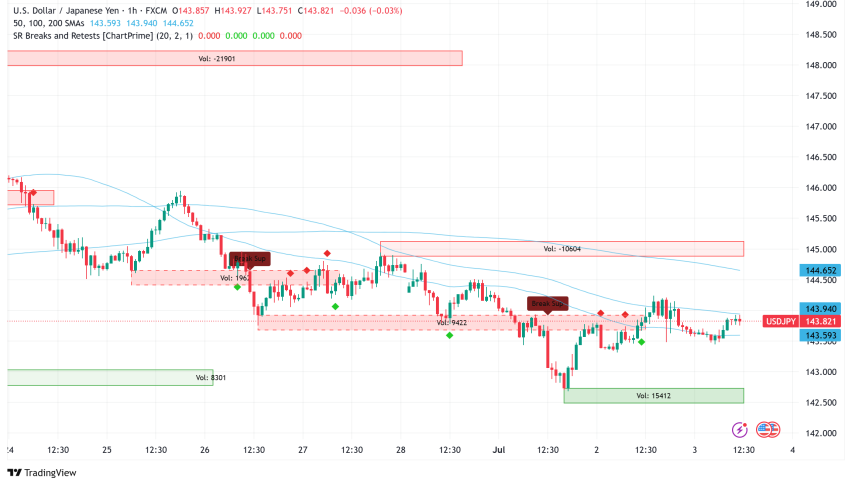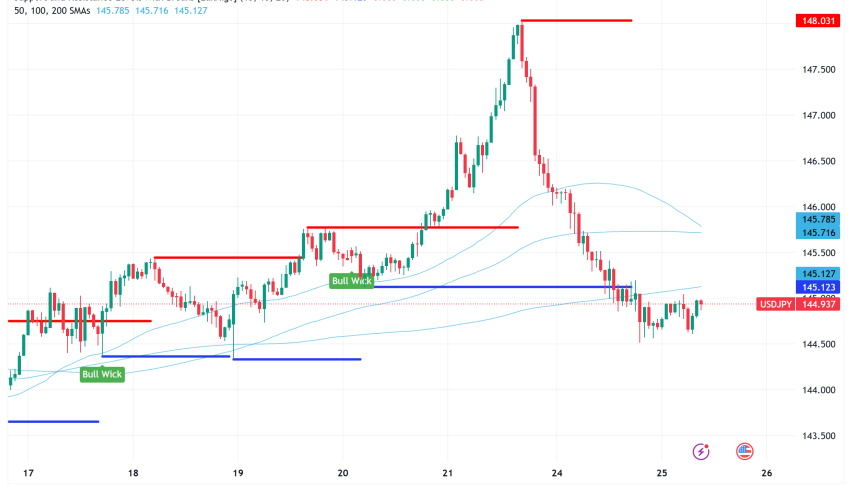Prices Forecast: Technical Analysis
For the daily forecast, USD/JPY is expected to close around 144.50, with a range between 144.00 and 145.00. The weekly forecast suggests a closing price of approximately 145.00, with a range from 143.50 to 146.00. The RSI is currently at 48.10, indicating a neutral trend, while the ATR at 1.50 suggests moderate volatility. The ADX at 10.51 reflects a weak trend, implying that significant price movements are unlikely in the short term. The MACD line is slightly negative, indicating bearish momentum, but the proximity to the signal line suggests potential for a reversal. The Bollinger Bands show a narrowing range, indicating reduced volatility and potential consolidation. Overall, the technical indicators suggest a cautious outlook with limited upside potential.
Fundamental Overview and Analysis
Recently, USD/JPY has shown a downward trend, reflecting broader market concerns about economic growth and inflation. The Core PCE Price Index in the U.S. remains a key driver, with expectations of a slight increase, which could influence the Federal Reserve’s monetary policy. Investor sentiment is cautious, with mixed signals from economic data and geopolitical tensions. Opportunities for USD/JPY may arise from shifts in interest rate expectations or changes in global risk appetite. However, risks include potential market volatility and regulatory changes affecting currency markets. Currently, USD/JPY appears fairly priced, with no significant overvaluation or undervaluation. Traders should monitor economic indicators and central bank communications for further insights.
Outlook for USD/JPY
The future outlook for USD/JPY is influenced by several factors, including economic conditions and central bank policies. In the short term, the pair may experience limited movement due to weak trend strength and moderate volatility. Over the next 1 to 6 months, USD/JPY could see fluctuations based on U.S. inflation data and interest rate decisions. Long-term forecasts (1 to 5 years) suggest potential appreciation if the U.S. economy strengthens and interest rates rise. External factors such as geopolitical tensions or global economic shifts could significantly impact the pair. Overall, USD/JPY is expected to remain range-bound in the near term, with potential for gradual appreciation in the long term.
Technical Analysis
Current Price Overview: The current price of USD/JPY is 144.35, slightly below the previous close of 144.34. Over the last 24 hours, the price has shown limited movement, indicating a lack of strong directional momentum. Support and Resistance Levels: Key support levels are at 144.09, 143.83, and 143.47, while resistance levels are at 144.71, 145.07, and 145.32. The pivot point is at 144.45, with the asset trading slightly below it, suggesting a bearish bias. Technical Indicators Analysis: The RSI at 48.10 suggests a neutral trend, while the ATR at 1.50 indicates moderate volatility. The ADX at 10.51 reflects weak trend strength. The 50-day SMA and 200-day EMA show no significant crossover, indicating a lack of strong trend signals. Market Sentiment & Outlook: Sentiment is currently neutral to bearish, with price action below the pivot and weak trend indicators. The lack of moving average crossover and moderate ATR suggest limited volatility and potential consolidation.
Forecasting Returns: $1,000 Across Market Conditions
The table below outlines potential returns on a $1,000 investment in USD/JPY under different market scenarios. In a Bullish Breakout scenario, a 5% price increase could result in an estimated value of $1,050. In a Sideways Range scenario, a 0% change would maintain the investment at $1,000. In a Bearish Dip scenario, a 5% decrease could reduce the investment to $950. These scenarios highlight the importance of market conditions in determining investment outcomes. Investors should consider their risk tolerance and market outlook when deciding to invest in USD/JPY. Practical steps include monitoring economic indicators, staying informed about central bank policies, and setting stop-loss orders to manage risk.
| Scenario | Price Change | Value After 1 Month |
|---|---|---|
| Bullish Breakout | +5% to ~$151.52 | ~$1,050 |
| Sideways Range | 0% to ~$144.35 | ~$1,000 |
| Bearish Dip | -5% to ~$137.13 | ~$950 |
FAQs
What are the predicted price forecasts for the asset?
The daily forecast for USD/JPY suggests a closing price around 144.50, with a range between 144.00 and 145.00. The weekly forecast indicates a closing price of approximately 145.00, with a range from 143.50 to 146.00.
What are the key support and resistance levels for the asset?
Key support levels for USD/JPY are at 144.09, 143.83, and 143.47. Resistance levels are at 144.71, 145.07, and 145.32. The pivot point is at 144.45, with the asset currently trading slightly below it.
Disclaimer
In conclusion, while the analysis provides a structured outlook on the asset’s potential price movements, it is essential to remember that financial markets are inherently unpredictable. Conducting thorough research and staying informed about market trends and economic indicators is crucial for making informed investment decisions.



